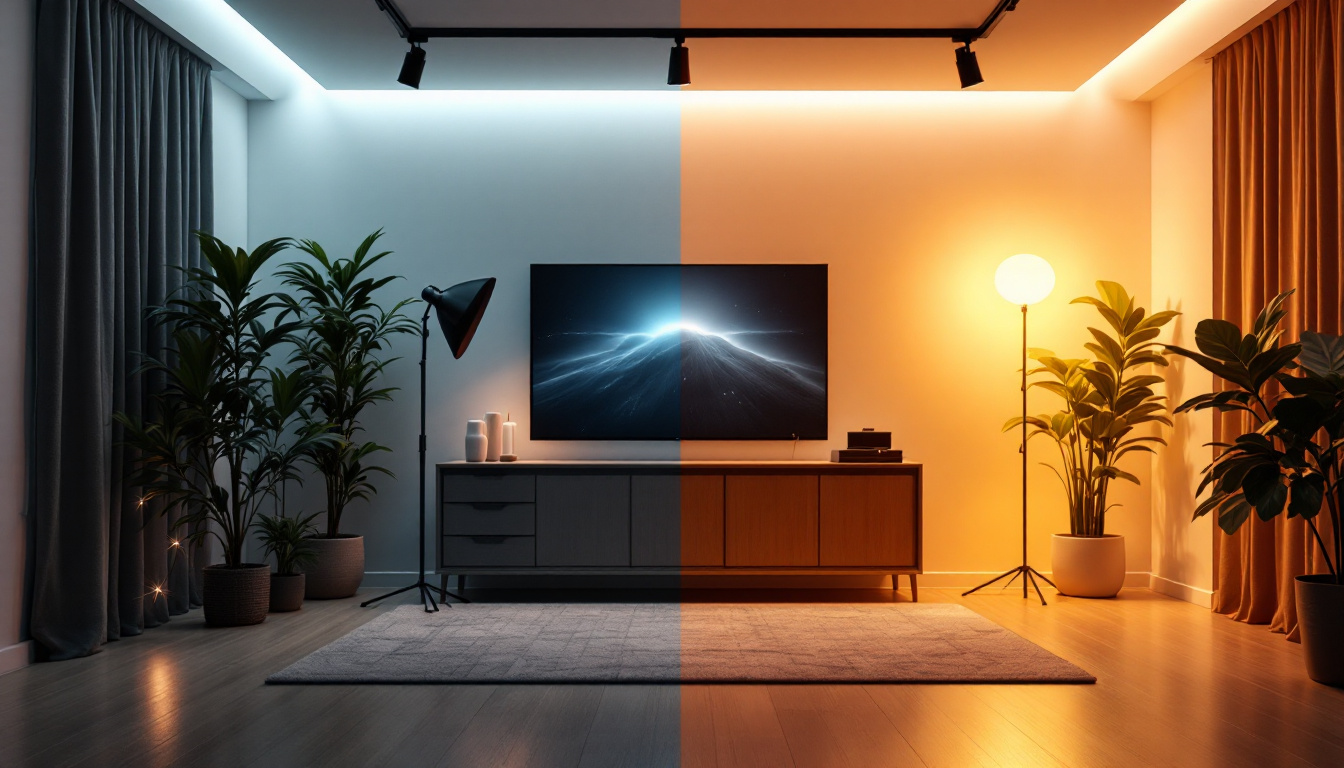

In the ever-evolving world of lighting design, strip lights have emerged as a popular choice among contractors and designers alike. Their versatility, ease of installation, and aesthetic appeal make them a go-to solution for various applications. However, with numerous alternatives available, it is essential for lighting contractors to weigh the pros and cons of strip lights against other options. This article delves into the characteristics of strip lights, explores their alternatives, and offers insights into what lighting contractors should consider when making their choices.
Strip lights, also known as LED tape lights or ribbon lights, are flexible circuit boards populated with light-emitting diodes (LEDs). They come in various lengths, colors, and brightness levels, allowing for a wide range of applications. Strip lights can be cut to size, making them adaptable to different spaces and designs. This versatility has made them a popular choice for both DIY enthusiasts and professional contractors, as they can be easily integrated into various projects, from home renovations to large-scale commercial installations.
These lights are available in both single-color and RGB options, providing contractors with the flexibility to create dynamic lighting effects. The adhesive backing on many strip lights makes installation straightforward, reducing labor time and costs. Furthermore, advanced models now offer features such as remote control and smartphone compatibility, allowing users to adjust brightness, color, and even set lighting schedules with ease. This technological integration enhances the user experience, making strip lights not just a functional choice but also a smart one.
One of the primary advantages of strip lights is their energy efficiency. LED technology consumes significantly less power compared to traditional incandescent or fluorescent bulbs, resulting in lower electricity bills for clients. Additionally, strip lights have a longer lifespan, reducing the frequency of replacements and maintenance. This longevity is particularly beneficial in commercial settings where lighting can be a significant ongoing expense, allowing businesses to allocate resources more effectively.
Strip lights also offer design flexibility. Their slim profile allows them to be installed in tight spaces, such as under cabinets, along staircases, or in coves. This adaptability makes them suitable for both residential and commercial projects, enhancing the overall aesthetic without overwhelming the space. Designers often use strip lights to create ambient lighting that highlights architectural features or artworks, adding depth and character to a room. The ability to customize the lighting scheme can transform ordinary spaces into extraordinary environments, making strip lights a favorite among interior decorators and architects alike.
Despite their many advantages, strip lights do have some limitations. One concern is the quality of light produced. While many strip lights offer a warm or cool white option, the color rendering index (CRI) can vary significantly between products. A lower CRI can result in colors appearing washed out or distorted, which may not meet the expectations of discerning clients. It is crucial for contractors to select high-quality strip lights with a CRI of 90 or above for applications where accurate color representation is essential, such as in art studios or retail environments.
Moreover, the installation of strip lights may require additional components, such as power supplies and controllers, which can complicate the setup process. Contractors must ensure that they are familiar with the necessary electrical requirements to avoid potential issues during installation. Additionally, some strip lights may not be rated for outdoor use, limiting their application in outdoor settings or exposed areas. Understanding these limitations is vital for contractors to provide clients with the best possible solutions tailored to their specific needs and environments.
Recessed lighting, often referred to as can lights or pot lights, is another popular option among lighting contractors. These fixtures are installed into the ceiling, creating a clean and streamlined look. Recessed lights can be used to provide general illumination or accent lighting, depending on the design and placement.
One of the main benefits of recessed lighting is its ability to create a sense of spaciousness in a room. By eliminating visible fixtures, the ceiling appears higher, making the space feel larger. Additionally, recessed lights are available in various sizes and styles, allowing for customization based on the specific needs of a project.
Track lighting consists of a series of lights mounted on a linear track, allowing for adjustable positioning and direction. This flexibility makes track lighting ideal for highlighting artwork, architectural features, or specific areas within a space.
Track lighting can be particularly beneficial in commercial settings, where the need for adaptable lighting solutions is paramount. It allows contractors to create dynamic lighting designs that can be easily modified as the space evolves. However, track lighting may not provide the same level of energy efficiency as strip lights, which is an important consideration for contractors focused on sustainability.
Wall sconces are decorative fixtures that provide ambient or task lighting while adding a touch of elegance to a space. They are available in various styles, from modern to traditional, allowing contractors to match the lighting design with the overall decor.
While sconces can enhance the aesthetic appeal of a room, they may not offer the same versatility as strip lights. Their fixed position limits the ability to adjust lighting direction, and they typically require more extensive installation compared to strip lights. However, when strategically placed, sconces can create a warm and inviting atmosphere.
When it comes to energy efficiency, strip lights often take the lead. Their LED technology consumes less power, which translates into lower energy bills over time. In contrast, traditional recessed lighting and some types of track lighting may still rely on less efficient incandescent or halogen bulbs, although LED options are becoming more common.
For contractors focused on sustainability and energy savings, strip lights present a compelling choice. However, it is essential to consider the specific lighting needs of the project, as some alternatives may offer comparable efficiency when equipped with modern LED options.
Strip lights shine in terms of installation ease and flexibility. Their adhesive backing allows for quick application in various locations, from under cabinets to along walls. This adaptability can significantly reduce installation time and labor costs.
In contrast, recessed lighting and wall sconces typically require more extensive installation, including cutting into ceilings or walls and ensuring proper electrical connections. Track lighting offers some flexibility, but its installation can be more complex than that of strip lights. For contractors looking to streamline their processes, strip lights may be the more practical option.
The aesthetic appeal of lighting is subjective and can vary based on the project’s design goals. Strip lights provide a modern, minimalist look that can be easily integrated into contemporary spaces. Their ability to create indirect lighting effects can enhance the ambiance without drawing attention to the fixtures themselves.
On the other hand, recessed lighting offers a clean and unobtrusive appearance, making it suitable for various design styles. Track lighting can add a more industrial or artistic flair, while wall sconces contribute a decorative element that can complement traditional or transitional designs. Ultimately, the choice will depend on the client’s preferences and the overall vision for the space.
Understanding the specific needs and preferences of clients is crucial for lighting contractors. Engaging in open discussions about lighting goals, desired aesthetics, and functional requirements will help guide the selection process. Some clients may prioritize energy efficiency, while others may focus on design flexibility or specific lighting effects.
By actively listening to clients and offering tailored recommendations, contractors can build trust and ensure that the final lighting design aligns with the client’s vision.
Budget considerations play a significant role in the decision-making process for lighting contractors. Strip lights often present a cost-effective solution, especially when factoring in energy savings and reduced maintenance costs. However, the initial investment in high-quality strip lights and necessary components should be weighed against alternatives.
Contractors should provide clients with a range of options, including budget-friendly solutions and higher-end alternatives. This approach allows clients to make informed decisions based on their financial constraints while still achieving their desired lighting outcomes.
The lighting industry is continuously evolving, with new technologies and trends emerging regularly. As smart lighting systems gain popularity, contractors should consider how strip lights and their alternatives can integrate with these advancements. Features such as remote control, color changing, and automation are becoming increasingly important to clients.
Staying informed about future trends will enable contractors to offer innovative solutions that meet the demands of modern consumers. By embracing new technologies, contractors can enhance their service offerings and remain competitive in the marketplace.
In the debate between strip lights and their alternatives, there is no one-size-fits-all answer. Each option has its unique advantages and drawbacks, making it essential for lighting contractors to evaluate the specific needs of each project. Strip lights offer versatility, energy efficiency, and ease of installation, while alternatives like recessed lighting, track lighting, and wall sconces provide distinct aesthetic and functional benefits.
Ultimately, the best choice will depend on client preferences, budget constraints, and the desired lighting effects. By carefully considering these factors and staying informed about industry trends, lighting contractors can make informed decisions that enhance their projects and satisfy their clients.
Ready to elevate your lighting projects with the best in the business? Look no further than LumenWholesale for a superior selection of strip lights and other lighting solutions that promise to meet your every need. Our commitment to quality, affordability, and convenience ensures that you get the most out of your investment. Whether you’re looking for energy efficiency, design flexibility, or the latest trends, we’ve got you covered. Take advantage of our unbeatable wholesale prices, hassle-free bulk buying, and free shipping. Don’t compromise on quality or cost—choose Wholesale Lighting at the Best Value with LumenWholesale and light up your projects with confidence.

Discover why purchasing under cabinet lighting in bulk from local distributors might not be the best choice.

Discover why purchasing industrial lighting in bulk from local distributors might not be the best choice.

Discover innovative strategies from expert lighting contractors on optimizing kitchen ceiling lights.

Discover essential tips and strategies for lighting contractors to navigate common challenges with Sylvania Light Bulb Company products.
Get notified when NEW deals are released.
Optimize your budget with wholesale discounts.
Only top-quality, specification-grade lighting products.
No additional costs at checkout - what you see is what you pay.
We understand the unique needs of contractors.